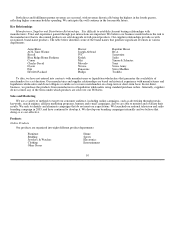Overstock.com 2006 Annual Report Download - page 20
Download and view the complete annual report
Please find page 20 of the 2006 Overstock.com annual report below. You can navigate through the pages in the report by either clicking on the pages listed below, or by using the keyword search tool below to find specific information within the annual report.
We face risks relating to our inventory.
We directly purchase some of the merchandise that we sell on our Websites. We assume the inventory damage, theft and
obsolescence risks, as well as price erosion risks for products that we purchase directly. These risks are especially significant because
some of the merchandise we sell on our Websites are characterized by rapid technological change, obsolescence and price erosion (for
example, computer hardware, software and consumer electronics), and because we sometimes make large purchases of particular
types of inventory. In addition, we often do not receive warranties on the merchandise we purchase. Further, beginning July 1, 2003,
we started accepting returns of products sold through our fulfillment partners, and we have the risk of reselling the returned products.
In the recent past, we have recorded charges for obsolete inventory and have had to sell certain merchandise at a discount or loss.
It is impossible to determine with certainty whether an item will sell for more than the price we pay for it. To the extent that we rely
on purchased inventory, our success will depend on our ability to liquidate our inventory rapidly, the ability of our buying staff to
purchase inventory at attractive prices relative to its resale value and our ability to manage customer returns and the shrinkage
resulting from theft, loss and misrecording of inventory. If we are unsuccessful in any of these areas, we may be forced to sell our
inventory at a discount or loss.
Historically, we have grown quickly and if we fail to manage our growth, our business will suffer.
Historically, we have rapidly and significantly expanded our operations, and anticipate that further significant expansion will be
required to address potential growth in our customer base and market opportunities. This expansion has placed, and is expected to
continue to place, a significant strain on our management, operational and financial resources. Some of our officers have no prior
senior management experience at public companies. Our new employees include a number of key managerial, technical and
operations personnel, and we expect to add additional key personnel in the future. To manage the expected growth of our operations
and personnel, we will be required to improve existing and implement new transaction-processing, operational and financial systems,
procedures and controls, and to expand, train and manage our already growing employee base. If we are unable to manage growth
effectively, our business, prospects, financial condition and results of operations will be harmed.
The loss of key personnel or any inability to attract and retain additional personnel could affect our ability to successfully
grow our business.
Our performance is substantially dependent on the continued services and on the performance of our senior management and
other key personnel, including Patrick M. Byrne, our Chief Executive Officer, and Jason C. Lindsey, our President and Chief
Operating Officer. Our performance also depends on our ability to retain and motivate other officers and key employees. The loss of
the services of any of our executive officers or other key employees for any unforeseen reason, including without limitation, illness or
call to military service, could harm our business, prospects, financial condition and results of operations. We do not have employment
agreements with any of our key personnel and we do not maintain "key person" life insurance policies. Our future success also
depends on our ability to identify, attract, hire, train, retain and motivate other highly-skilled technical, managerial, editorial,
merchandising, marketing and customer service personnel. Competition for such personnel is intense, and we cannot assure you that
we will be able to successfully attract, assimilate or retain sufficiently qualified personnel. Our failure to retain and attract the
necessary technical, managerial, editorial, merchandising, marketing and customer service personnel could harm our revenues,
business, prospects, financial condition and results of operations.
We generally pay our senior management, including our executive officers, lower levels of cash compensation than we believe
they might be able to earn elsewhere. Our stock option plan and performance share plan are intended to and do help us recruit and
retain highly qualified personnel;
19
























